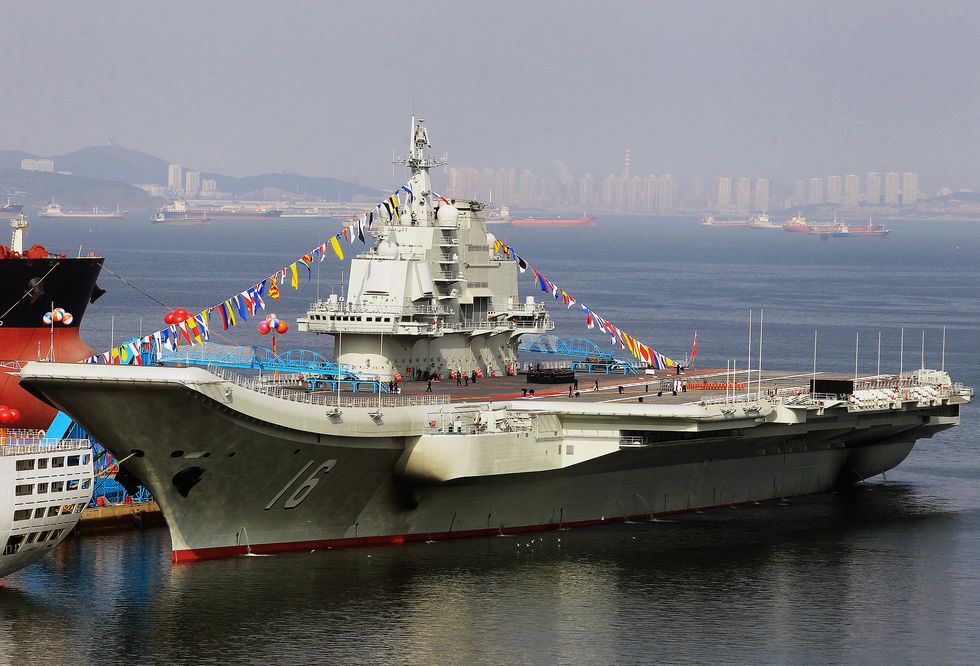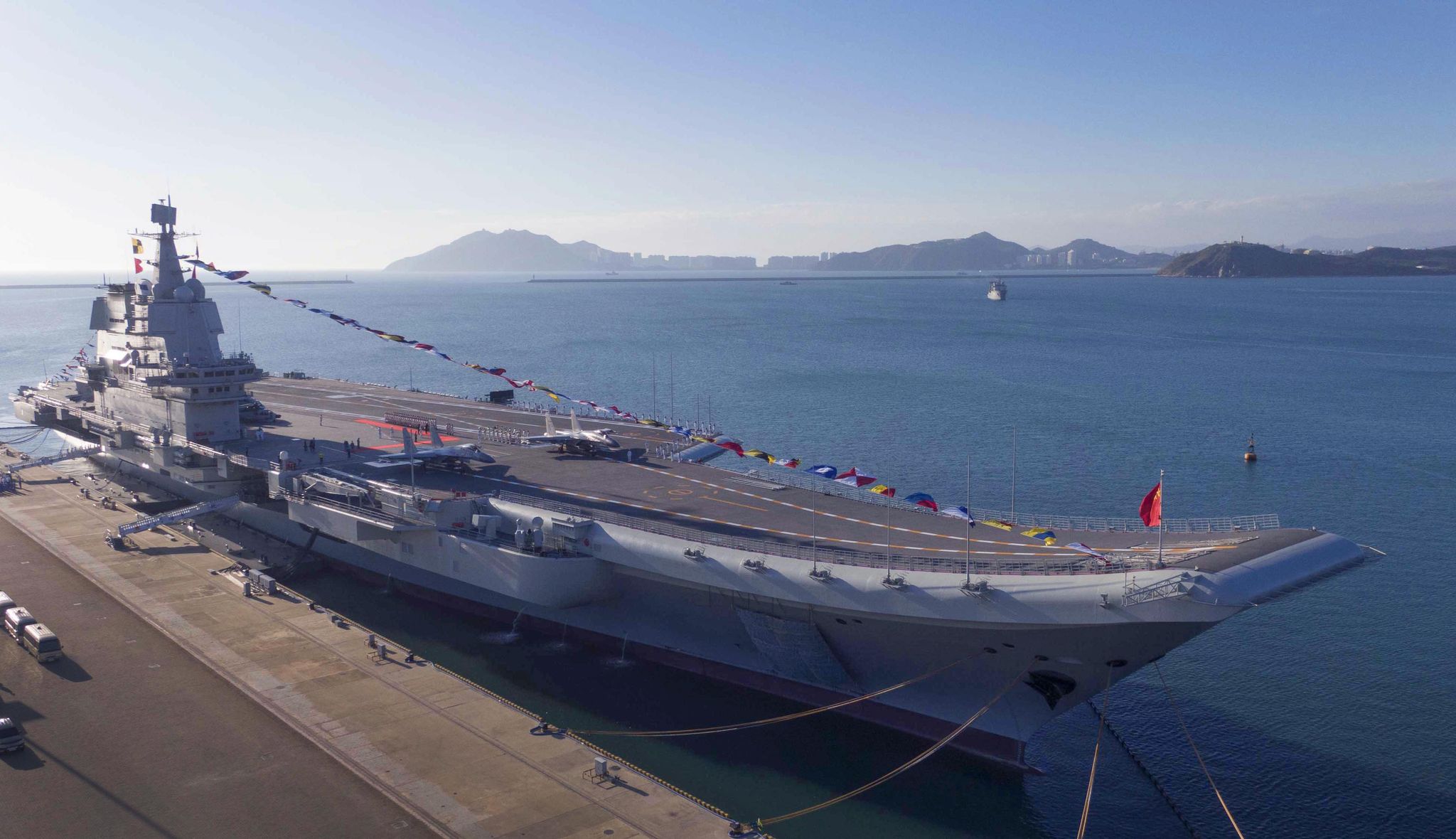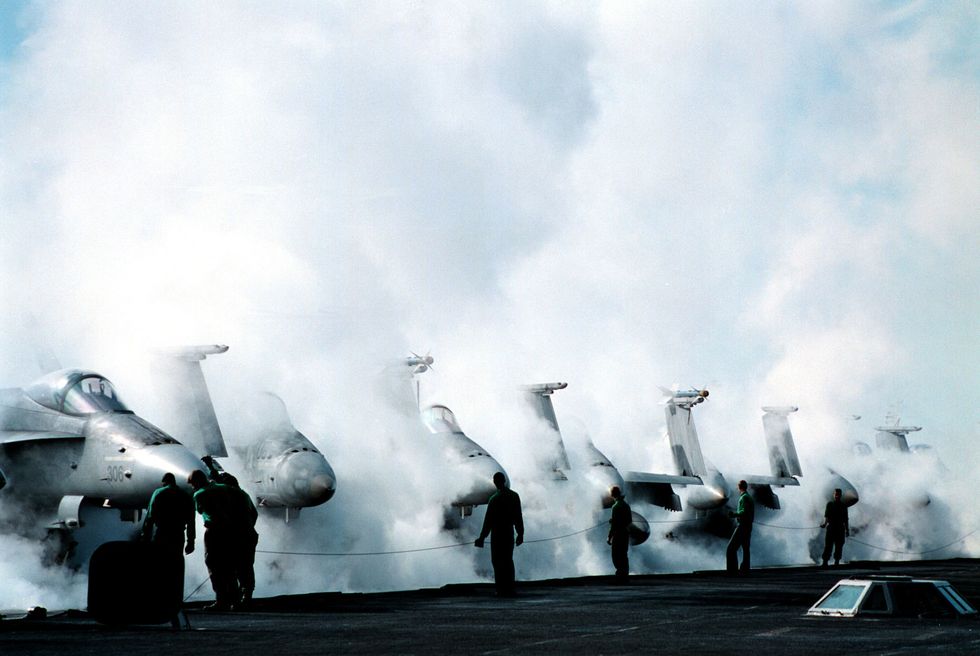𝙏𝙤 𝙍𝙪𝙡𝙚 𝙩𝙝𝙚 𝙎𝙚𝙖𝙨, 𝘾𝙝𝙞𝙣𝙖 𝙉𝙚𝙚𝙙𝙚𝙙 𝙖 𝙈𝙖𝙟𝙤𝙧 𝙏𝙚𝙘𝙝 𝘽𝙧𝙚𝙖𝙠𝙩𝙝𝙧𝙤𝙪𝙜𝙝—𝙄𝙩 𝙈𝙖𝙮 𝙃𝙖𝙫𝙚 𝙅𝙪𝙨𝙩 𝙁𝙤𝙪𝙣𝙙 𝙊𝙣𝙚
The People’s Liberation Army Navy (PLAN) has built three aircraft carriers in just 12 years. China inducted Liaoning in 2012, Shandong in 2019, and Fujian is set to enter service sometime in 2024 or 2025. The tech on the first two gigantic warships, built to project power abroad, has lagged behind America’s state-of-the-art carrier technology. They were built without aircraft catapults, instead lofting planes into the air with the use of ski ramps.
Now, it seems Fujian—China’s most advanced warship yet—will change that.
Part of an unprecedented peacetime naval buildup, Fujian is China’s largest ship ever, and it reportedly uses new electromagnetic aircraft launch technology similar to what the U.S. Navy uses on America’s latest carrier, USS Gerald R. Ford. The relentless push forward in naval aviation shows China’s eagerness to match—or even exceed—the capabilities of the mighty U.S. Navy.
Crawl, Walk, Run
Getty ImagesChina’s first aircraft carrier, Liaoning, uses a ski-ramp system to launch planes into the sky. Ultimately, this technology is inferior to what the U.S. uses on its own carriers.
China’s first carrier, Liaoning, was originally built for the Soviet Union, but the breakup of the USSR in 1991 left it an incomplete hulk. A Hong Kong businessman bought the ship from its inheritor, Ukraine, and sent it to China where it was completed and made ready for flight operations. Liaoning is 1,005 feet long, displaces 60,000 tons, and carries about 40 aircraft at a time: 24 J-16 strike fighters with the rest being a mixture of anti-submarine and utility helicopters.
Liaoning uses a bow-mounted ski ramp to get aircraft into the air. Airplanes, including the Shenyang J-16 strike fighter, light their afterburners and then roll down the flight deck toward the ramp. The ramp rockets the plane skyward, whereupon lift and engine power take over and send the plane over the bow. While simple and elegant, aircraft must carry less fuel and munitions than they would during normal takeoffs in order to keep the weight down. Aircraft without afterburning turbine engines, like the American C-2 Greyhound transport, cannot operate from ski ramps as they are unable to gain enough speed to keep them airborne.

Getty ImagesThe aircraft carrier Shandong is similar to Liaoning in that it also uses a ski ramp to propel fighter jets. When these carriers were built, China still lacked the know-how to build a catapult system.
Advertisement – Continue Reading Below
Shandong, the PLAN’s second carrier, is in many ways a copy of its predecessor, with the main difference being it was entirely built in China. Shandong has all of Liaoning’s shortcomings, particularly the use of a bow-mounted ski ramp instead of a catapult to help fighter jets take off. While U.S. carriers have used steam-powered catapults for more than a half-century, China has lacked the expertise to build them.
Modern steam-powered catapults, introduced in the 1950s, were game-changers for the U.S. Navy. Steam, generated in the bowels of the ship, is piped up to the flight deck, where it builds pressure behind a series of pistons connected to a bar on the flight deck. Once the pistons are released, an aircraft attached to the bar lurches forward along grooves in the deck, accelerating to takeoff speed.
The Navy used steam for more than 70 years. Steam allows carriers to launch aircraft carrying more weapons and fuel, giving them greater firepower and range than aircraft launched using ski ramps. Catapults, operating independently of aircraft power, can launch prop-driven planes like the C-2.
If China wanted better, more efficient carriers, it needed to perfect some form of catapult technology in time for its third carrier, Fujian. And that’s exactly what it did, according to reports from China.
Beneath the Decks
Getty ImagesSteam filtering out from the catapult system has long been a hallmark of carrier flight deck operations.
In 2017, the U.S. Navy commissioned USS Gerald R. Ford, the lead ship of the Ford-class carriers. Ford was fitted with the Electromagnetic Aircraft Launch System, or EMALS. EMALS replaces the steam catapults and pressure with a catapult using electromagnetism and stored kinetic energy. Wiring replaces steam ducts, and the system can be tuned to accommodate drones. EMALS is capable of generating up to 270 aircraft launches a day in wartime—33 percent more than steam catapults. It’s also noticeably quieter, making the lives of sailors on board a little less stressful.
Advertisement – Continue Reading Below
The U.S. Navy was the first in the world to use an electromagnetic system. In 2017, just as Ford was being commissioned, reports out of China claimed the People’s Liberation Army Navy (PLAN) was making great strides in developing its own electromagnetic launch system. These reports were made with some skepticism, as the EMALS system aboard Ford was still experiencing technical issues that would take several more years to iron out.
China Catches Up

Wikimedia CommonsA model of Fujian showing its three electromagnetic catapult stations: two on the bow and one positioned off the angled flight deck.
Advertisement – Continue Reading Below
News of the EMALS-like breakthrough in China coincided with the construction of a third carrier, Fujian. It measures 1,036 feet long, just 71 feet shorter than the U.S. Navy’s USS Gerald R. Ford. Fujian, at 80,000 tons fully loaded, weighs 20 percent less than Ford. Fujian is not only the first clean-sheet carrier design China has built, it’s also the largest Chinese warship ever built.
Like Ford, Fujian includes an angled flight deck, allowing a carrier to perform both takeoffs and landings without departing and returning aircraft getting in each other’s way. It also has two elevators to transport aircraft between the hangar and flight deck. Fujian’s most notable advance is that it has catapults, three of them to Ford’s four. Fujian’s real accomplishment lies beneath the flight deck, though: the ship also uses electromagnetic catapults.

Getty ImagesA satellite image of Fujian in 2022, showing its angled flight deck. This Chinese carrier is notable because it reportedly includes three catapult systems, whereas its predecessor ships, Liaoning and Shandong, only used ski ramps to launch aircraft.
Advertisement – Continue Reading Below
Fujian’s launch system reportedly differs from the American approach. According to the South China Morning Post, the Chinese system was inspired by the drive trains of electric cars, using a flywheel and winding wheel to store and release energy. Once released, the stored energy uses a steel cable to pull an aircraft down the flight deck and into the air. The flywheel and winding wheel aren’t physically connected, instead bound to one another by an “eddy current clutch” that generates a strong electromagnetic force.
Unlike the Chinese system, with its wheels, steel cables, and transfer bar, the American system is more advanced and has fewer moving parts—just the bar that travels down the magnetized channel, pulling the airplane along. Still, the adoption of electromagnetic launch technology is a considerable accomplishment for a country that fielded its first carrier just 12 years ago.
Fujian will likely enter service within the next year or two, bringing the total number of Chinese aircraft carriers up to three. While this is still half as many carriers as the U.S. Pacific Fleet, if the pace continues, China could catch up in another dozen years or so. China is clearly attempting to master both quantity and quality—quickly—at the same time. The big question is: why?
China has made no secret of its desire to build up a navy strong enough to push the United States out of the Western Pacific. It has also refused to rule out the use of force to reunite Taiwan with mainland China, and has pressed expansionist territorial claims in the South China Sea. The situation is similar to the 1930s, when another power, Japan, built up a large carrier force to forge and retain an empire. Then again, the only major power in a position to stop those imperial ambitions was the United States. History may well be repeating itself.